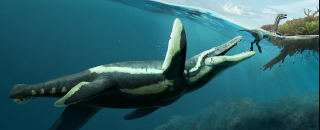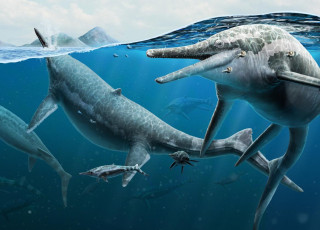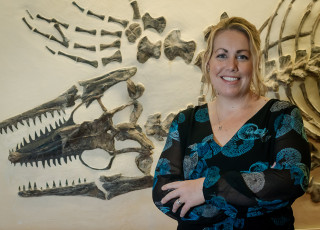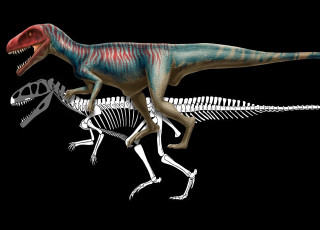Monsters of the Sea: Diving Into Ancient Underwater Worlds
This article was published in advance of DinoFest, an event which took place at NHMU on January 25 and 26, 2025. The event explored ancient underwater worlds and marine reptiles.
By Olivia Barney
When we think of sea monsters, images of mythological creatures surface — enormous tentacles wrapping around ships, razor-sharp teeth sinking into sharks with ease, and stealthy swimmers emerging from the depths of the sea. They’re images made popular by art, film, and literature throughout history — images designed to shock audiences.
While many of these creatures were invented to sell movie tickets, we can’t look at fossils from large, prehistoric ocean-dwellers without admitting that some could be considered sea monsters in their own right. NHMU’s 2025 DinoFest event is taking a deep dive into prehistoric underwater worlds to showcase the fascinating and terrifying creatures that lived within the ancient deep. During the event, guests will have a rare opportunity to explore our paleontology collections space, ask world-renowned experts their burning questions, and explore the world of dinosaurs through hands-on activities all weekend long. It’s one of our most popular events of the year — a weekend festival designed for dinosaur enthusiasts of all ages! As we countdown the days until this massive underwater exploration begins, we’re bringing you sneak peeks of what you can look forward to during the event.
NHMU’s Paleontology & Mineralogy Collections Manager, Carrie Levitt-Bussian, cares for our specimens the way a librarian cares for her collection of books. This includes the proper care and organization of specimens, coordinating research efforts onsite and between institutions, embarking on excavations, training volunteers, and so much more. But despite her busy schedule, Levitt-Bussian is always excited to share her enthusiasm with inquiring minds. In preparation for DinoFest: Underwater Worlds, she shared a few of her favorite sea monsters with us.
The Helicoprion "Whorl Shark" and Its Spiral of Teeth
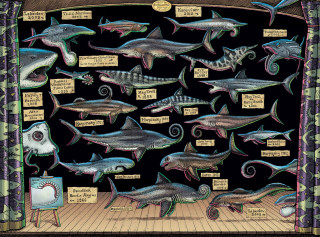
Helicoprion Hypotheses Artwork © Ray Troll 2013, used by permission
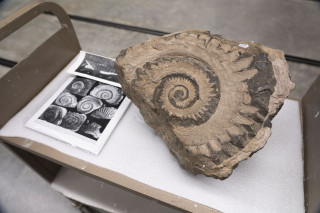
Photo by Jack Rodgers / NHMU
The Helicoprion is an ancient shark-like creature that lived during the Permian, a time just before the dinosaurs we know and love. Its most distinctive feature, the tooth whorl, is a massive spiral of teeth that filled its lower jaw, continually growing throughout its life. When the first tooth whorl was originally found, it was thought to be ammonite, a fossilized spiral shell. As more fossils were discovered, researchers realized that each distinctive triangle along the spiral was a tooth!
Over the years, experts have tried to identify what this “whorl shark” may have looked like — a challenging puzzle given the cumbersome roll of teeth emerging from its lower jaw. This ancient creature of the deep continues to intrigue paleontologists across the globe — and has led to a plethora of ideas on what this creature may have looked like.
Ichthyosaur Eyes Reveal Prehistoric Secrets
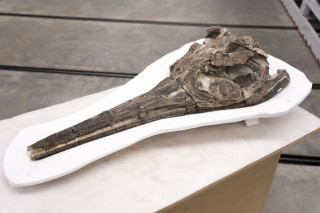
Photo by Jack Rodgers / NHMU
Meet Baptanodon, an ichthyosaur found just outside of Dinosaur National Monument in Utah. Imagine a large creature that somewhat resembles a dolphin — but instead of a tail fin that moves up and down, the Baptanodon’s tail fin moved from side to side (more like a shark)! Its skull featured a long nose, like the dolphins of today, but its eyes are what capture experts’ attention.
Many reptiles have sclerotic rings, bones in the eye that offer support for animals with non-spherical eyes or those that live in underwater worlds. They’re particularly strong and developed in animals that need to move really quickly (like birds or fish). When sclerotic rings are well preserved, they can teach us a lot about the animal they belonged to, allowing researchers to estimate eye and cornea size. There’s a growing body of research that suggests these rings may also help determine the age of some ichthyosaur species! The holes within sclerotic rings changed in size as the ichthyosaur developed from juvenile to adult, helping determine the relative age of the preserved species.
Giant Crocodiles Take On Tyrannosaurs
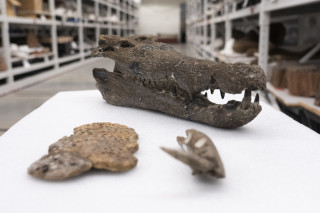
Photo by Jack Rodgers / NHMU
Crocodiles and alligators are famously thought of as modern dinosaur relatives, and while the term dinosaur only applies to a specific group of prehistoric beasts, the crocodilian ancestors of the past were just as ferocious as any tyrannosaur. The skull displayed here is from the Eocene (about 50 million years ago), so it’s from a time a bit after the dinosaurs lived. It’s remarkably well preserved, and a favorite within our paleontology collection.
Deinosuchus, however, is a crocodilian from the age of the dinosaurs! This terrifying beast was a predator so fearsome that it could give Tyrannosaurus rex a run for its money. Deinosuchus was the largest crocodile of all time — approximately the size of a school bus — lurking in the dark depths, ready to strike at unsuspecting dinosaurs as they drank from the water. You can see Deinosuchus for yourself in our Past Worlds exhibition; and during DinoFest, you can see even more ferocious fossils from our collections.
